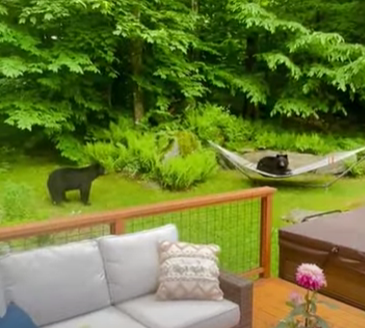Waitsfield bear visit video prompts warning from wildlife officials
June 14, 2024 | By Emma Cotton | VTDigger.org This story was first published by VTDigger on June 13.
Screenshot from Noah Dweck’s bear video.
Officials from the Vermont Department of Fish & Wildlife are warning that a viral video showing two black bears in a Waitsfield backyard — one of which appears to be relaxing on a hammock — isn’t as cute as it looks.
Instead, it’s an example of increasingly common human-bear encounters in Vermont, which can turn dangerous for both bears and people. In May, a game warden euthanized a bear in Underhill after it repeatedly displayed aggressive behavior toward a person.
Noah Dweck, the videographer and homeowner, told VTDigger that he was sitting in his home office on Tuesday when he heard the chains of his hammock jingling in the backyard, and he knew immediately that it was “the bears.”
With his home situated in a mountainous section of the Mad River Valley, Dweck and his wife, Kristen, are aware that they live in bear country. They have taken a number of measures to keep bears away — a piece of context viewers wouldn’t know from the video, which the Associated Press published on Wednesday. Bears have tried to get into their dumpsters, which are secured with bear bars, Dweck said, and they’ve climbed into their truck bed.
Screenshot from Noah Dweck video showing two bears in his backyard.
Dweck said the couple keeps the garbage and recycling secure, does not use bird feeders, and takes care not to leave food in cars or outdoor areas.
“We definitely make sure that we don’t have anything that’s attracting them,” he said. “They’re just around.”
David Sausville, who leads the department’s wildlife restoration management and research section, said he was particularly concerned to see the Waitsfield bears’ apparent lack of fear when Dweck approached them and yelled at them to leave. Dweck said he was concerned by this behavior, too.
“I came out, and was like, ‘Hey!’ and they just kind of stared at me, which is what they like to do, because they’re so used to us,” he said.
After catching a video of the bear swinging in the hammock, Dweck said he used an air horn, which he keeps handy, to scare the bears away.
Sausville said the Fish & Wildlife Department has logged more than 400 human-bear encounters already this year, and he expects this year’s number to exceed last year’s 880 recorded encounters.
Wildlife officials recently told VTDigger that up until 2016, the department anticipated roughly 130 reports of bear encounters each year. In 2020, there were 1,700 reports, and in 2022, there were 1,400.
“There’s a lot of cubs that have been brought up, through the years, with these females that know where the food is, and now they’re out on their own,” Sausville said. “So we’ve got a whole generation of bears that have learned, ‘humans mean food,’ and that’s not a good situation.”
Sausville said bears are commonly attracted most by garbage and recycling left unsecured, bird feeders left up in the summer, grills and food residue outside and compost that isn’t handled properly and creates smells.
Although seeing a bear can be exciting, scaring the bear away and making it uncomfortable near humans will help to keep the animal safer, he said. He recommends using an air horn, yelling or banging pots and pans to scare the animals.
“There have been cases out west where they’ve shown, when those communities come together, everybody — the homeowners, the restaurants with their dumpsters, the trash haulers — they’ve actually reduced substantially the number of bear incidents,” he said.
Most of that success comes from small behavioral changes on the part of humans, he said.
People can report bear encounters and learn more about preventing bear-human encounters at the Vermont Fish & Wildlife Department’s website.


